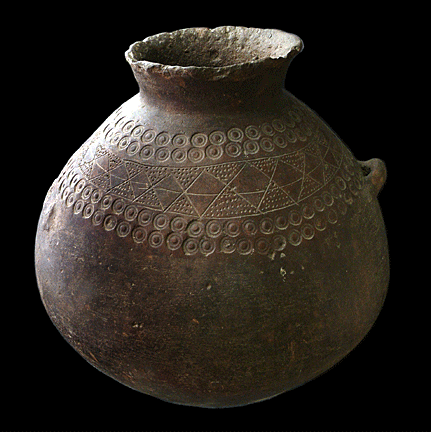 Pottery
has been around since the ancient people roamed the earth. As one of
the oldest human inventions, the practice of pottery has developed
alongside civilization. The earliest ceramic objects have been dated
as far back as 29,000 BCE. Because clay has always been abundant,
cheap, and adaptable, pottery was independently invented in many
parts of the world at different times.
Pottery
has been around since the ancient people roamed the earth. As one of
the oldest human inventions, the practice of pottery has developed
alongside civilization. The earliest ceramic objects have been dated
as far back as 29,000 BCE. Because clay has always been abundant,
cheap, and adaptable, pottery was independently invented in many
parts of the world at different times.
The introduction of pottery usually coincided with the beginnings of
an agricultural lifestyle, when people needed durable and strong
vessels and containers. First and foremost, pottery served as
household wares for the storage, preparation, transport, and
consumption of food, drink, and raw materials.
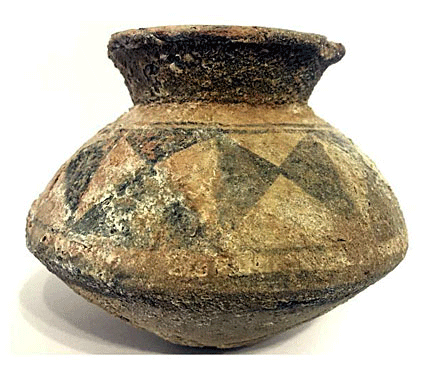 At
first, people made pottery by baking it in open fires. Around 8,000
BCE, peoples of the Near East used special ovens to parch cereal
grains and to bake bread. These allowed people to control fire and
produce high temperatures in enclosed facilities.
At
first, people made pottery by baking it in open fires. Around 8,000
BCE, peoples of the Near East used special ovens to parch cereal
grains and to bake bread. These allowed people to control fire and
produce high temperatures in enclosed facilities.
Early potters used relatively low firing temperatures, ranging from
about 1112° to about 1472° to 1652° F., to make their pottery.
Eventually, potters began firing their wares in a kiln. The first
kilns appeared around 6000 BCE in what’s now Iraq in the Middle
East—originally as pit kilns, then as stone-lined kilns---enabling
potters to achieve much higher temperatures when firing, thus
improving the reliability and durability of their pots. To fire clay
vessels in a pit kiln, the early potters placed the fuel in the
bottom of a shallow pit followed by their pottery, then placed
additional fuel in the upper layer.
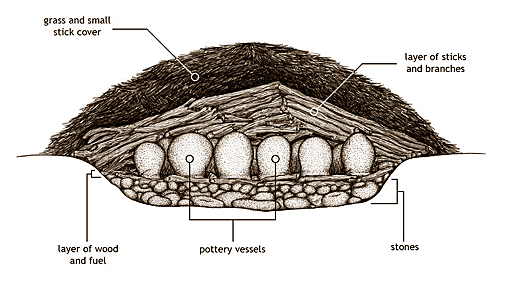
 An
early form of enclosed kiln consisted of a temporary domed structure
formed of pieces of turf, straw and clay, which the potter built up
on a framework around the pots as he stacked them, and which he
removed when the firing had completed. The pots rested on a series
of clay firebars, and some of these kilns had a permanent vented
floor.
An
early form of enclosed kiln consisted of a temporary domed structure
formed of pieces of turf, straw and clay, which the potter built up
on a framework around the pots as he stacked them, and which he
removed when the firing had completed. The pots rested on a series
of clay firebars, and some of these kilns had a permanent vented
floor.
Another type of kiln was an updraft kiln, a cylindrical construction
divided into two compartments. The potter placed fuel in the lower
compartment, then placed the unfired pottery in the upper
compartment. This allowed the heat to rise, allowing the pottery to
fire at a temperature level normally ranging from 1832° to 2192° F.

In some cases, potters could change the color of the earthenware
from its natural reddish tone to gray without the need of pigments,
merely by manipulating the temperature and air influx into the kiln
during the firing process.
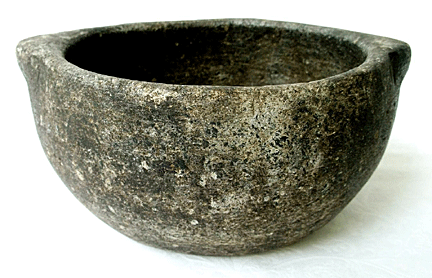 For
primitive Stone Age cooking pots, all that was needed was a supply
of clay and a source of heat. Thus most Chinese pottery until about
10,000 BCE was roughly made earthenware, fired in bonfires for a
short time at temperatures up to 1652° F. Potters made vessels with
round bottoms to avoid any sharp angles or rims that would be more
prone to cracking. They didn’t glaze their pieces and limited
decoration coiled clay "ropes."
For
primitive Stone Age cooking pots, all that was needed was a supply
of clay and a source of heat. Thus most Chinese pottery until about
10,000 BCE was roughly made earthenware, fired in bonfires for a
short time at temperatures up to 1652° F. Potters made vessels with
round bottoms to avoid any sharp angles or rims that would be more
prone to cracking. They didn’t glaze their pieces and limited
decoration coiled clay "ropes."
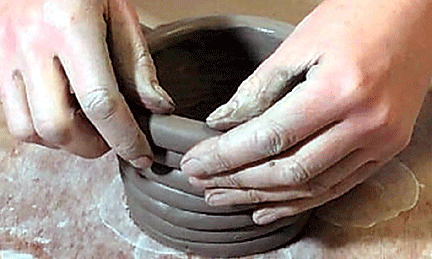 Potters
hand-formed the earliest pots from slabs of reddish-brown clay,
leaving them undecorated and unglazed. But by 6,000 BCE, they had
introduced a variety of decorative techniques involving intricate
painted designs.
Potters
hand-formed the earliest pots from slabs of reddish-brown clay,
leaving them undecorated and unglazed. But by 6,000 BCE, they had
introduced a variety of decorative techniques involving intricate
painted designs.
Between 18,000 and 12,000 BCE the art of pottery spread from the
China mainland across East Asia. It eventually appeared in Japan by
14,500 BCE), in the Amur River Basin by 14,000 BCE, in sub-Saharan
Africa by 9,500 BCE, in Persia by 8,000 BCE, in the Middle East by
7,000 BCE, in the Americas by 5500 BCE, and in the Indian
sub-continent by 5,500 BCE.
The potter's wheel first appeared in Mesopotamia between 6,000 and
4,000 BCE, leading to a surge in pottery vessels of all types and
sizes.
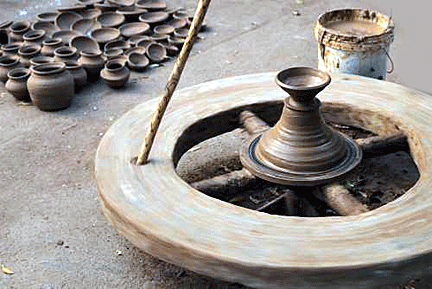
Egyptian Pottery
The Egyptians were one of the first cultures in the world to create
pottery. They began to make pottery about 4,000 BCE, 10,000 thousand
years later than the Chinese. They had developed an excellent
farming-based civilization, and archaeologists believe they made
pottery to store grains and food items. They formed the most common
vessels from Nile clay, also called Nile silt. After being fired, it
has a red-brown color.
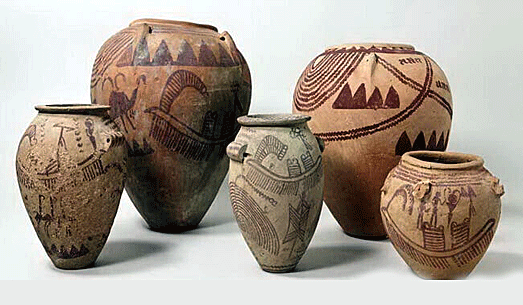
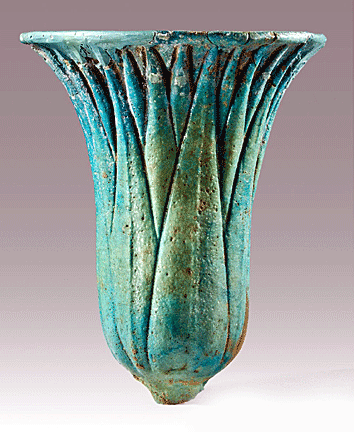 By
this time, advanced kiln designs enabled potters to fire their
pottery up to 2192° F. This brought forth a variety of new technical
possibilities. Small groups of potters, rather than by individual
artisans making ceramic containers for their families, produced most
Egyptian pottery. As the region became wealthier and more organized,
the types and characteristics of ceramic vessels became more varied,
and demand rose. Potters began using more molds in order to speed up
production, and glazing became widespread.
By
this time, advanced kiln designs enabled potters to fire their
pottery up to 2192° F. This brought forth a variety of new technical
possibilities. Small groups of potters, rather than by individual
artisans making ceramic containers for their families, produced most
Egyptian pottery. As the region became wealthier and more organized,
the types and characteristics of ceramic vessels became more varied,
and demand rose. Potters began using more molds in order to speed up
production, and glazing became widespread.
Potters decorated their pieces by pushing the clay into plaster
molds, instead of by painting it on. Molding the decoration was much
faster and cheaper than painting it.
The most famous type of Egyptian pottery was faience. Potters
crushed together quartz/sand crystals with calcium, magnesium,
potassium, sodium, and copper oxide. Then they formed the resulting
paste into shapes and fired them. During heating, the shapes would
harden and develop bright colors and a glassy finish. The Egyptian
word for faience means "shining" because the Egyptians believed
faience reflected the light of immortality.
Ancient Greek Pottery
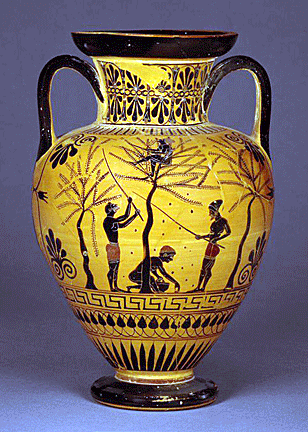 Ancient
pottery reached its peak in classical Greece, with the manufacture
and decoration of vases, amphoras and hydria. The origins of Greek
excellence date between 3000 and 2000 BCE when Aegean art superceded
Thessaly as the leading pottery center. Minoan art also contributed
to this Aegean renaissance.
Ancient
pottery reached its peak in classical Greece, with the manufacture
and decoration of vases, amphoras and hydria. The origins of Greek
excellence date between 3000 and 2000 BCE when Aegean art superceded
Thessaly as the leading pottery center. Minoan art also contributed
to this Aegean renaissance.
The finest pottery came from Crete, home of the Minoan civilization,
between 2,000 and 1,800 BCE. Peoples throughout the Mediterranean
region sought Minoan pottery..
The resurgence of Greek art began about 900 BCE, with the appearance
of Geometric Style Greek pottery between 900 and 725 BCE, which
produced some of the finest works of Greek ceramic art. This was
followed from about 725 BCE onwards, by the Oriental Style of Greek
pottery between.725 and
 600
BCE, influenced by Greek colonies in Asia Minor. Athens and Corinth,
on the Greek mainland, became the two major centers of pottery
making.
600
BCE, influenced by Greek colonies in Asia Minor. Athens and Corinth,
on the Greek mainland, became the two major centers of pottery
making.
The high point of Greek pottery occurred between 600 and 480 BCE,
with the development of "black figure" pottery, in which potters
painted designs in black onto red clay vases, followed by "red
figure" pottery in which they filled the undesigned area in with
black paint, to contrast with the incised designs colored in red.
Roman Pottery
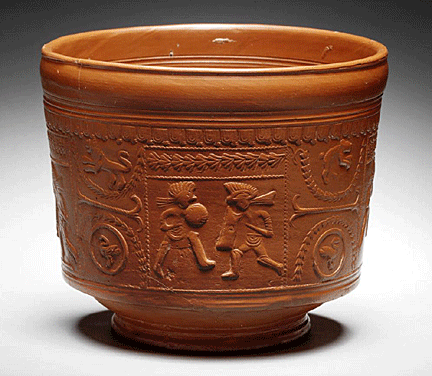 Roman
pottery was initially influenced by Etruscan and Greek style but
later on established its own separate identity. Unlike Greek pottery
in which potters painted decorations on the pottery, Romans
preferred to engrave them. The most common fine ware pottery was the
red glazed pottery called “terra sigilata.”
Roman
pottery was initially influenced by Etruscan and Greek style but
later on established its own separate identity. Unlike Greek pottery
in which potters painted decorations on the pottery, Romans
preferred to engrave them. The most common fine ware pottery was the
red glazed pottery called “terra sigilata.”
While the Greeks preferred painted decoration, the Romans was more
inclined towards relief decoration on their pottery using colored
slips, finishes, and glazing.
Roman pottery can be divided into three categories:
Amphorae:
The Romans used this type of pottery to store, carry, and ship
products, especially olive oil and wine. Amphorae were usually not
decorated although the finish might suit the type of product the
amphora was meant to carry. They were often stamped with a maker’s
signature to show provenance.
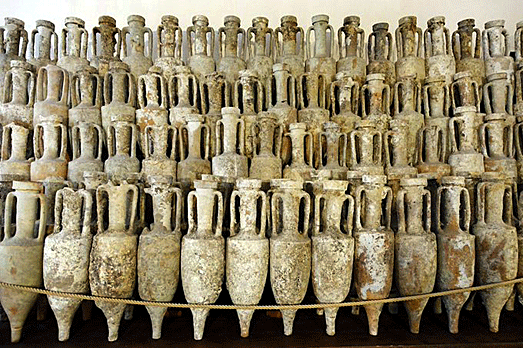
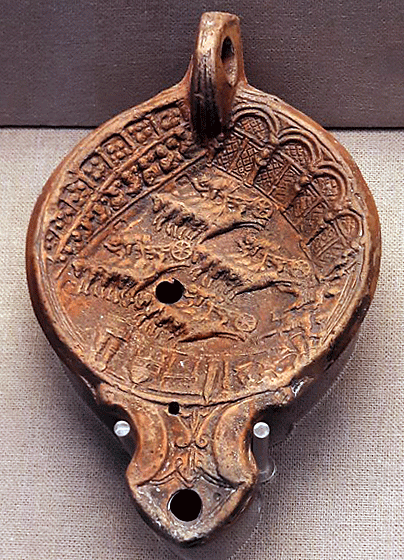 Coarse
ware: The Romans used this
type of pottery, the most common, for everyday necessities,
especially cooking. It was, as the name states, coarse. As the name
implies its finish went as far as satisfying utilitarian needs. The
Romans produced Coarse Ware in greater quantities because it tended
to break easily. Also, potters made the walls of the pots thicker to
make the ware more resistant to heat and heavy use.
Coarse
ware: The Romans used this
type of pottery, the most common, for everyday necessities,
especially cooking. It was, as the name states, coarse. As the name
implies its finish went as far as satisfying utilitarian needs. The
Romans produced Coarse Ware in greater quantities because it tended
to break easily. Also, potters made the walls of the pots thicker to
make the ware more resistant to heat and heavy use.
Fine ware:
Wealthy Romans often possessed better pottery which combined
functional and decorative elements and was often painted or even
glazed. The shapes of Fine Ware pottery dictated its use as special
showcase pieces, as vessels to hold cosmetics, or to be used on
special occasions and dinners. If Fine Art pottery had any painted
decoration, it usually took the form of geometric patterns and
designs.
The Romans used glazing very little. If they used any decoration at
all, the Romans employed figurative shallow relief, either made with
a mold and applied to the surface of a pot or drawn directly onto
the surface by squirting a semi-thick clay through a nozzle.
